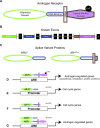Molecular mechanisms underlying resistance to androgen deprivation therapy in prostate cancer
- PMID: 27487144
- PMCID: PMC5325456
- DOI: 10.18632/oncotarget.10901
Molecular mechanisms underlying resistance to androgen deprivation therapy in prostate cancer
Abstract
Prostate cancer (PCa) is the most widely diagnosed male cancer in the Western World and while low- and intermediate-risk PCa patients have a variety of treatment options, metastatic patients are limited to androgen deprivation therapy (ADT). This treatment paradigm has been in place for 75 years due to the unique role of androgens in promoting growth of prostatic epithelial cells via the transcription factor androgen receptor (AR) and downstream signaling pathways. Within 2 to 3 years of ADT, disease recurs-at which time, patients are considered to have castration-recurrent PCa (CR-PCa). A universal mechanism by which PCa becomes resistant to ADT has yet to be discovered. In this review article, we discuss underlying molecular mechanisms by which PCa evades ADT. Several major resistance pathways center on androgen signaling, including intratumoral and adrenal androgen production, AR-overexpression and amplification, expression of AR mutants, and constitutively-active AR splice variants. Other ADT resistance mechanisms, including activation of glucocorticoid receptor and impairment of DNA repair pathways are also discussed. New therapies have been approved for treatment of CR-PCa, but increase median survival by only 2-8 months. We discuss possible mechanisms of resistance to these new ADT agents. Finally, the practicality of the application of "precision oncology" to this continuing challenge of therapy resistance in metastatic or CR-PCa is examined. Empirical validation and clinical-based evidence are definitely needed to prove the superiority of "precision" treatment in providing a more targeted approach and curative therapies over the existing practices that are based on biological "cause-and-effect" relationship.
Keywords: ADT; androgen receptor; castrate-recurrent; prostate cancer; splice variant.
Conflict of interest statement
The authors have declared no competing interests.
Figures

References
-
- Society AC, editor. Cancer Facts & Figures 2015. Atlanta: American Cancer Society; 2015.
-
- Catalona WJ, Richie JP, Ahmann FR, Hudson MA, Scardino PT, Flanigan RC, deKernion JB, Ratliff TL, Kavoussi LR, Dalkin BL, et al. Comparison of digital rectal examination and serum prostate specific antigen in the early detection of prostate cancer: results of a multicenter clinical trial of 6,630 men. J Urol. 1994;151:1283–90. - PubMed
Publication types
MeSH terms
Substances
Grants and funding
LinkOut - more resources
Full Text Sources
Other Literature Sources
Research Materials
Miscellaneous

